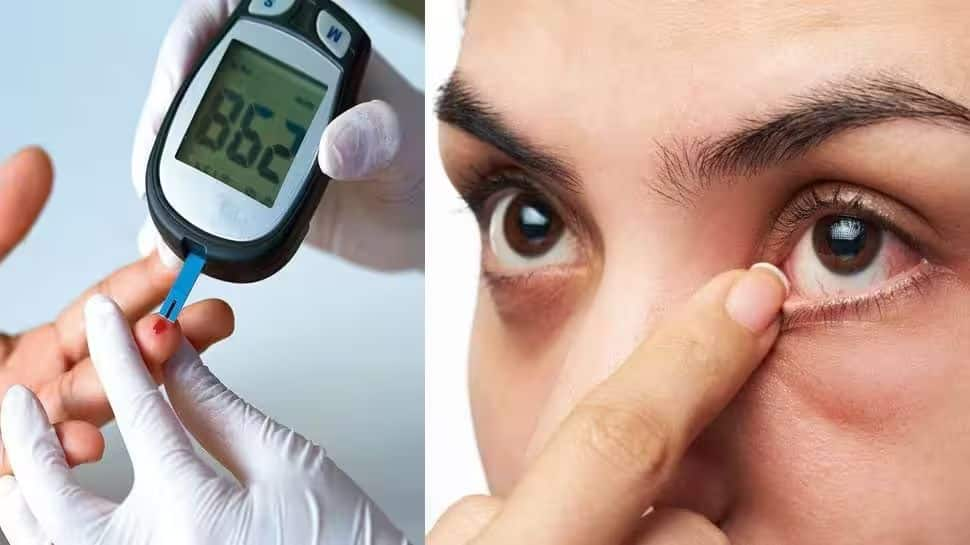With excessive stress and no work-life balance, high blood sugar or diabetes has become a lifestyle disease now. Diabetes not only affects blood sugar levels but can have a significant impact on eye health. Diabetes can also increase the risk of other eye problems, including cataracts and glaucoma. Early detection and treatment of diabetic retinopathy, cataracts, and glaucoma can help prevent or slow down their progression and preserve vision.
High blood sugar levels associated with diabetes can damage the blood vessels in the retina, leading to a condition called diabetic retinopathy. This can cause changes in vision and, in severe cases, even lead to blindness. Hence, people with diabetes should get regular eye check-ups to monitor for any changes in their vision or eye health.
It’s also important for people with diabetes to manage their blood sugar levels through healthy eating, exercise, and medication as prescribed by their healthcare provider.
Dr Mandeep Singh Basu, CEO of Jagat Pharma and Director of Dr Basu Eye Hospital explains how diabetes can affect eyesight, what are the warning signs to look out for, and what precautionary measures one should take.
Also read: High Blood Sugar: How Stress Can Impact Diabetes, Expert Explains
High Blood Sugar: How Is Diabetes Linked With Eye Health?
Dr Mandeep shares that the eye is one of the most significant sense organs, and maintaining appropriate eye function is crucial for general health and well-being. Prameha, or diabetes, is one of the eight primary illnesses according to the ancient Ayurvedic scripture Charaka Samhita. In Ayurveda, diabetic retinopathy is referred to as Prameha/Madhumehajanya Timir and is characterised by an imbalance of the blood, the seven tissues, the three ‘doshas’ (vata, pitta, and kapha), and the raktadosha (blood).
The four visions of the eyes are affected by the condition at various stages. Diabetes Retinopathy is a complication of diabetes. ‘Pitta’ and ‘rakta’ dosha imbalances, which concentrate on the eyes and induce microangiopathy, haemorrhages, and venous beading, can be the cause of diabetic retinopathy.
Are Vision Problems For Diabetic People Permanent?
“If diabetic retinopathy is not treated or progresses to later stages, the accumulation of ‘ama’ may cause vision problems for diabetes patients that result in permanent damage to the eyes. It may lead to retinal detachment, optic nerve damage, vitreous haemorrhage, and other conditions that could permanently harm eyes and vision. To preserve healthy vision, it is crucial to have medical help,” Dr Basu said.
How Does Diabetes Cause Blurry Vision?
Dr Basu shares that diabetes can lead to leaky blood vessels in the macula, the area of the retina where sharp, correct vision is produced. As a result of the macula’s enlargement and haemorrhages, vision may become distorted or blurry.
Diabetes And Eye Health: Warning Signs To Look Out For
Dr Basu claims that diabetic retinopathy can cause a variety of symptoms, including blurred or distorted vision, eye floaters, and rapid changes in vision due to vitreous haemorrhage in more advanced stages of the disease. Early diagnosis and treatment of the illness can help to maintain vision and avert permanent harm.
High Blood Sugar: Precautionary Measures Diabetics Should Take To Maintain Eye Health
Certain lifestyle modifications and Ayurvedic practices can help a diabetic person maintain eye health. Dr Basu advises following tips:
1) Diabetics should have their eyes examined at regular intervals and control their blood sugar levels. “Controlling blood sugar levels is crucial in preventing the development and progression of diabetic retinopathy,” Dr Basu said.
2) A diet high in antioxidants and low in glycemic index, according to Ayurvedic research, may help stop the onset and progression of diabetic retinopathy.
3) Maintaining a routine that includes regular exercise and stress-reduction exercises like yoga and meditation will enhance blood sugar regulation and stop the build-up of ama.
4) Ayurvedic practices including netra tarpana, Shirodhara, Shirovasti, Abhyanga, Tratak meditation, nasya, and Panchakarma can help preserve eye health.
Diabetes Leads To Eye Floaters?
The condition is known as eye floaters, in which particles or strands of debris float in the field of vision, which can indeed be brought on by diabetes. Damage to the retina’s blood vessels brought on by diabetes increases the risk of bleeding and the development of scar tissue. The feeling of floaters in the vision is caused by haemorrhage or leaked blood that is floating in the vitreous chamber of the eye.
One of the main causes of eye floaters is diabetes, which can be avoided by controlling blood sugar levels.
High Blood Sugar: Ayurvedic Tips To Safeguard Vision During Diabetes
One can prevent serious eye damage brought on by diabetes by adhering to a Pitta-balancing diet and lifestyle, getting frequent eye exams, controlling blood sugar levels, and seeking advice from a skilled Ayurvedic practitioner.
In Ayurveda, the treatment of diabetic retinopathy includes various approaches:
– Treating the root cause of the disease, i.e., diabetes (madhumeha)
– Managing Raktapitta, which is a condition characterized by bleeding disorders
– Improving blood circulation to the eyes
– Prevention of loss of dhatu (tissue)
– Maintaining samagni, which refers to balanced digestive fire
– Using Dipana pachana drugs such as Trikatu churna and chitrakadi to correct mand agni (weak digestion) at the tissue level
– Administering mrudu virechana and nasya for the purification of impurities in the srotas/capillaries
– Using basti for shodhana (cleansing) and shamana (palliative) treatments of vata dosha.
– Administering seka to improve the texture of blood vessels, repair endothelium, and prevent the loss of pericytes, which is an initial factor in DR development.
– Using Nasya, Shirodhara, shirolepa, and Shiro Pichu treatments for vata shaman treatment for the head and body and pitta shaman treatment for the eyes, depending on the stage of diabetic retinopathy.
– Administering Takradhara and netra seka for both cure and prevention, which help reduce stress and anxiety that cause blood glucose levels to rise.
– Using rasayana therapies, which include rejuvenating formulations that provide deep healing.




